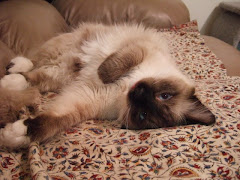I don't know how I failed to come across this during the last 30 years, but I have just been acquainted with it and, of course, just love it. I have actually read several different versions in which language has been changed, references slightly modified and bits added and deleted. My guess is that it was ultimately printed in a number of places and perhaps over the years he modified it... at any rate, it is a First Class piece...
***********************
Our solid American citizen awakens in a bed built on a pattern that originated in the Near East but that was modified in Northern Europe before it was transmitted to America. He throws back covers made from cotton, domesticated in India, or linen, domesticated in the Near East, or silk, the use of which was discovered in China. All of these materials have been spun and woven by processes invented in the Near East. He slips into his moccasins, invented by the Indians of the Eastern woodlands, and goes to the bathroom, whose fixtures are a mixture of European and American inventions, both of recent date. He takes off his pajamas, a garment invented in India, and washes with soap, invented by the ancient Gauls. He then shaves - a masochistic rite that seems to have been derived from either Sumer or ancient Egypt.
Returning to the bedroom, he removes his clothes from a chair of southern European type and proceeds to dress. He puts on garments whose form originally derived from the skin clothing of the nomads of the Asiatic steppes, puts on shoes made from skins tanned by a process invented in ancient Egypt and cut to a pattern derived from the classical civilizations of the Mediterranean, and ties around his neck a strip of bright colored cloth that is a vestigial survival of the shoulder shawls worn by 17th century Croatians. Before going out for breakfast, he glances through a window, made of glass invented in Egypt, and, if it is raining, puts on overshoes made of rubber discovered by the Central American Indians and takes an umbrella, invented in Southeastern Asia. Upon his head he puts a hat made of felt, a material invented in the Asiatic steppes.
On his way to breakfast, he stops to buy a paper, paying for it with coins, an ancient Lydian invention. At the restaurant, a whole new series of borrowed elements confronts him. His plate is made from pottery, invented in China. His knife is steel, an alloy first made in southern India; his fork, a medieval Italian invention; and his spoon, a derivative of a Roman original. He begins his breakfast with an orange, from the eastern Mediterranean, a cantaloupe from Persia, or perhaps a piece of African watermelon. With this he has coffee, an Abyssinian plant, with cream and sugar. Both the domestication of cows and the idea of milking them originated in the Near East, while sugar was first made in India. After his fruit and first coffee, he goes for waffles, cakes made by a Scandinavian technique from wheat domesticated in Asia Minor. Over these he pours maple syrup, invented by the Indians of the Eastern woodlands. As a side dish, he may have the egg of a species of bird domesticated in Indochina, or the thin strips of the flesh of an animal domesticated in eastern Asia that have been salted by a process developed in Northern Europe.
When our friend has finished eating, he settles back to smoke, an American Indian habit, consuming a plant domesticated in Brazil in either a pipe, derived from the Indians of Virginia, or a cigarette, derived from Mexico. If he is hardy enough, he may even attempt a cigar, transmitted to us from the Antilles by way of Spain. While smoking, he reads the news of the day, imprinted in characters invented by the ancient Semites upon a material invented in Germany. As he absorbs the accounts of foreign troubles, he will, if he is a good, conservative citizen, thank a Hebrew deity in an Indo-European language that he is 100% American.
Linton, Ralph. The study of man : an introduction. New York : Appleton-Century. 1936
Dad - Being his typical silly self...

We miss you dad!
















